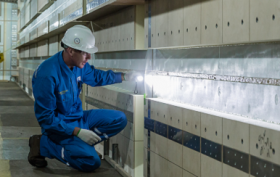
Cutting edge technologies and unparalleled know-how
GTT offers proven, safe and efficient technologies for containment of liquefied gases in cryogenic conditions during shipping, onshore or offshore storage.
GTT originally developed its “membrane” technologies to cut the cost of shipping liquefied natural gas (LNG) and loading it, in bulk, into the vessel’s holds. To cope with the cargo, holds need to be coated with a cryogenic lining that can withstand the load. Envelopes, known as membranes, contain the LNG at a temperature of -163°C, sealing it with a totally impermeable layer between the liquid cargo and the vessel’s hull, while also limiting cargo loss through evaporation.
GTT has two main techniques for creating membrane tanks, its Mark and NO systems. These systems, which have been approved by the international classification societies responsible for maritime transport, are continuously improved in response to shipowners’ operational and financial requirements and changes in regulations. Today, thanks to the know-how of its experienced team of engineers, GTT is well positioned to expand its offering into new and promising markets, providing bespoke technological solutions for multi-gas vessels and small and mid-scale carriers, as well as new applications for the fast-growing market in bunkering, using LNG as a propulsion fuel.
GTT’s proven membrane containment systems, critical to the shipping industry, have met with indisputable success. The systems use thiner and lighter materials than rival systems. They have several distinctive advantages:
- Optimization of cargo storage space;
- Reduced vessel construction and operation costs;
- Modular design allowing for flexible assembly in vessels of all sizes without significant capital expenditures.
THE MEMBRANE TECHNOLOGIES ARE DIRECTLY SUPPORTED BY THE SHIP’S INNER HULL


